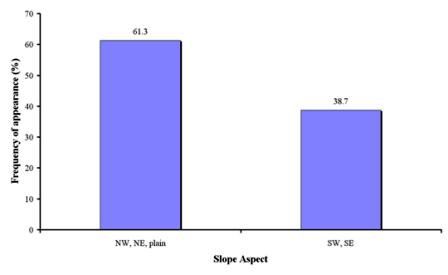Slope aspect
Slope aspect is defined as the orientation of the lands with respect to the sun. Slope aspect is considered an important factor for land degradation processes affecting the microclimatic conditions by regulating the angle and the duration at which the sun's rays strike the surface of the soil. Variation in slope aspect and elevation influence the distribution of energy, atmospheric water, plant nutrients and vegetation by varying the exposure of the soil to wind and precipitation and the conditions for natural drainage and soil erosion. In Mediterranean climatic conditions slopes with southern and western facing aspects are warmer and have higher evaporation rates than northern and eastern aspects. Therefore, a slower recovery of vegetation is expected on southern and western aspects, and higher erosion rates than on northern and eastern aspects. As a consequence, southern exposed slopes usually are more degraded or are more sensitive to desertification than northern exposed slopes.
Slope aspect in this study has been defined by using a compass or by assessing the relative land's surface with respect to the magnetic north. The following classes have been defined: (a) N, NW, NE, (b) S, SW, SE, and (c) plain areas.
As Table 3 shows this indicator has been described in 1141 field sites, corresponding to 14 study sites. The majority of the cases measured (61.2%) are northern facing slopes or plain areas, while the rest (38.7%) are southern facing slopes (Fig. 20). Both slope aspect classes have been identified in all study sites.

Fig. 20. Distribution of slope aspect classes defined in the study field sites